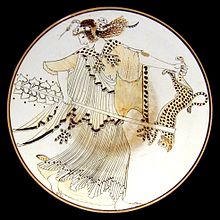
Summary
Nebris (νεβρίς; or nebride, from νεβρός, ‘fawn’) is a fawn skin, similar to an aegis, originally worn as a hunter's clothing item and later attributed to Dionysus (Euripides, Le Baccanti, 99, 125, 157, 790; Aristophanes, Le rane, 1209; Dionigi il Periegeta, 702, 946; Rufo Festo Avieno, 1.129).[1]


As a young boy, Dionysus was wrapped in such a brown, brightly spotted fur as protection against Hera, who was seeking his life because he was the son of Zeus and a mortal woman, Semele. Accordingly, the nebris was adopted by his followers in processions and ceremonies that were held in his honor during the liturgical celebrations of the Dionysia.[2][3][4]
In works of ancient art it is seen not only on maenads and male bacchantes, but also on figures of Pan and satyrs. It is commonly worn in the same way as the aegis, or goatskin, by tying the two front legs over the right shoulder in order to allow the body of the skin to cover the left side of the wearer.[5] A woodcut from the work Vases by Sir William Hamilton (I, 37), reproduces a priestess of Bacchus in the act of offering a nebris to the god or one of his ministers.
References edit
- ^ James Yates, Nebris, from William Smith, A Dictionary of Greek and Roman Antiquities, John Murray, London, 1875 (from the LacusCurtius website)
- ^ Thomas McEvilley, The Shape of Ancient Thought, Allsworth press, 2002, pp. 118–121. Google Books preview
- ^ Reginald Pepys Winnington-Ingram, Sophocles: an interpretation, Cambridge University Press, 1980, p. 109 Google Books preview
- ^ Zofia H. Archibald, in Gocha R. Tsetskhladze (Ed.) Ancient Greeks west and east, Brill, 1999, pp. 429 ff.Google Books preview
- ^ Ovid, Metamorphosis, VI, 593


